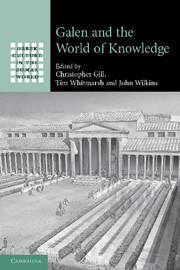Book contents
- Frontmatter
- Contents
- Notes on contributors
- Note on conventions
- Preface
- Introduction
- 1 Galen's library
- 2 Conventions of prefatory self-presentation in Galen's On the Order of My Own Books
- 3 Demiurge and Emperor in Galen's world of knowledge
- 4 Shock and awe: the performance dimension of Galen's anatomy demonstrations
- 5 Galen's un-Hippocratic case-histories
- 6 Staging the past, staging oneself: Galen on Hellenistic exegetical traditions
- 7 Galen and Hippocratic medicine: language and practice
- 8 Galen's Bios and Methodos: from ways of life to path of knowledge
- 9 Does Galen have a medical programme for intellectuals and the faculties of the intellect?
- 10 Galen on the limitations of knowledge
- 11 Galen and Middle Platonism
- 12 ‘Aristotle! What a thing for you to say!’ Galen's engagement with Aristotle and Aristotelians
- 13 Galen and the Stoics, or: the art of not naming
- Bibliography
- Index
Introduction
Published online by Cambridge University Press: 06 August 2010
- Frontmatter
- Contents
- Notes on contributors
- Note on conventions
- Preface
- Introduction
- 1 Galen's library
- 2 Conventions of prefatory self-presentation in Galen's On the Order of My Own Books
- 3 Demiurge and Emperor in Galen's world of knowledge
- 4 Shock and awe: the performance dimension of Galen's anatomy demonstrations
- 5 Galen's un-Hippocratic case-histories
- 6 Staging the past, staging oneself: Galen on Hellenistic exegetical traditions
- 7 Galen and Hippocratic medicine: language and practice
- 8 Galen's Bios and Methodos: from ways of life to path of knowledge
- 9 Does Galen have a medical programme for intellectuals and the faculties of the intellect?
- 10 Galen on the limitations of knowledge
- 11 Galen and Middle Platonism
- 12 ‘Aristotle! What a thing for you to say!’ Galen's engagement with Aristotle and Aristotelians
- 13 Galen and the Stoics, or: the art of not naming
- Bibliography
- Index
Summary
GALEN AS AN INTELLECTUAL IN HIS CULTURAL CONTEXT
The recent discovery of Galen's treatise On the Avoidance of Grief in a monastery in Thessaloniki provides a vivid picture of his intellectual life in Rome. Writing in the familiar ancient genre of the consolation, in the manner of Cicero, Seneca or Plutarch, Galen responds to the letters from an unnamed friend who admired his fortitude. Galen had managed to refrain from grief in the face of disaster, first an epidemic of plague among his slaves, and then the destruction of his books, drug supplies and medical instruments in the terrible fire that swept through the Temple of Peace and nearby buildings close to the Palatine hill in Rome in AD 192. With much topographical detail, Galen gives a clear description of the Temple of Peace district and the libraries and storehouses built around the Via Sacra, and his attempts to move valuable items he had at home into store for safe-keeping while he went on a trip to Campania. Disastrously, fire struck and he lost more cinnamon than the merchants could replace, a number of medical instruments, in particular wax moulds for special instruments he was about to commission from the metalworkers, and many books. The books included classic works by Theophrastus, Aristotle and Chrysippus, many of them annotated by Galen, with errors in punctuation and other anomalies removed.
- Type
- Chapter
- Information
- Galen and the World of Knowledge , pp. 1 - 18Publisher: Cambridge University PressPrint publication year: 2009



